Home Safety Checklist For Reno
Keeping safe in your home should be your number one concern. But are you overlooking some key safety components? Take this home safety checklist for Reno and discover where your home requires some work.
This guide begins with a few whole-home safety items, and then we break it down to specific room ideas. Then, phone (775) 316-7001 or complete the form below for more information.
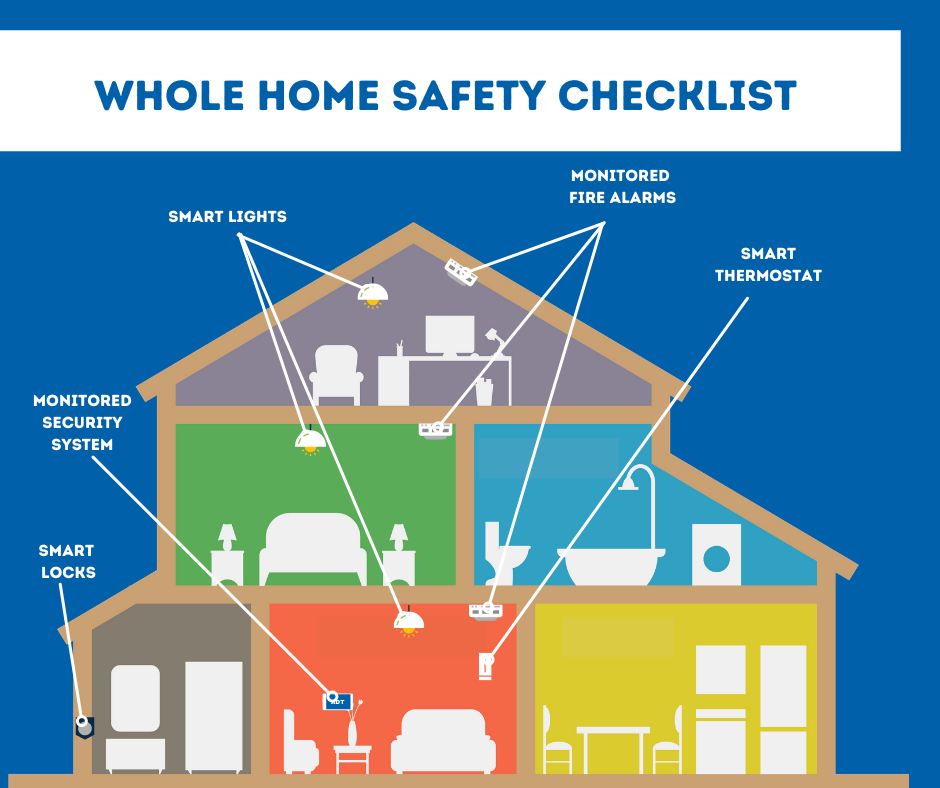
Basic Home Safety Checklist for Reno
While you should use a room-to-room approach to home safety, there are a few things that work for a lot of your rooms. These components can sync with one another through a touchscreen hub, and can even work off other components. You might also control every one of your home safety equipment through a mobile app, like ADT Control:
-
Monitored Home Security System: All your windows and doors should use a sensor that alerts you and your family to a break-in. After the alarm trips, your monitoring agent responds to the alert and immediately sends a first responder.
-
Smart Lights For Most Rooms: Sure, you can program your smart lighting so your house is more efficient. But they can also help you remain safe during an emergency. Make your smart bulbs come on when a sensor trips to frighten off intruders or illuminate your way to a safe area.
-
Smart Thermostat: Likewise, a smart thermostat in Reno could save you between 10%-15% in gas and electric spending. Also, it can turn on your exhaust fan if you have a fire.
-
Monitored Smoke Detectors: It’s code that you should have a fire alarm on each level of your house. You can increase your fire game by utilizing a monitored fire detector that senses excessive heat and smoke, and alerts your 24-hour monitoring team when it thinks that there’s a fire.
-
Smart Locks: Every doorway that needs a keyed lock can be made safer with a smart lock. Now you can program key codes to each family member and receive texts to your smartphone when your locks are used. Your doors can even automatically turn off, letting you quickly flee the house during a fire or other emergency.
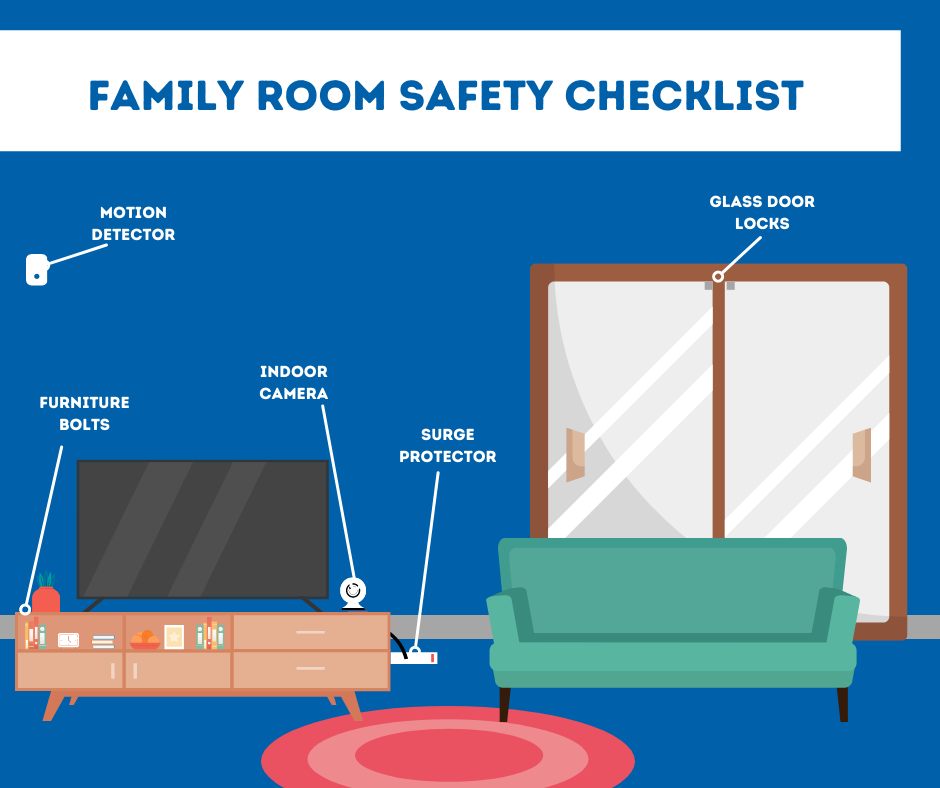
Family Room/Living Room Safety Checklist For Reno
You’ll spend a lot of time in your family room, so it may be the best place to start your home safety optimization. Electronics, like your TV or stereo system, typically reside in your living room, making it a popular room for burglars. Start with hanging a motion detector or indoor security camera in your room, then try the following safety protocols:
-
Motion Detectors: By installing motion sensors, you’ll have a shrieking alarm anytime they sense unusual motion in your family room. You’ll want motion detectors that aren’t set off by pets or you’ll see your sirens go off each time your cat roams by for a midnight stroll.
-
Indoor Camera: An indoor security camera puts an eye on your family room. View constant feeds of everything so you can know what’s going on without leaving your bed. Or chat with your family in the family room using the two-way talk feature.
-
Surge Protector/Outlet Maintenance: Safeguard expensive electronics and stop overloading your outlets with a surge protector. For added comfort, use a smart plug with surge protection in the unit.
-
Heavy Furniture Bolted To The Wall: If you have any small children, you’ll want to secure your entertainment center or other heavy furniture to a wall. This is extra crucial if your family room has carpet that could make furniture extra unstable.
-
Enhanced Locks For Sliding Glass Doors: If your living room has a sliding glass door that leads to a deck, patio, or outside porch, you know that the latch is usually flimsy. Install a special lock, like a cross bar or small locks that are located on the top and bottom of the frame.
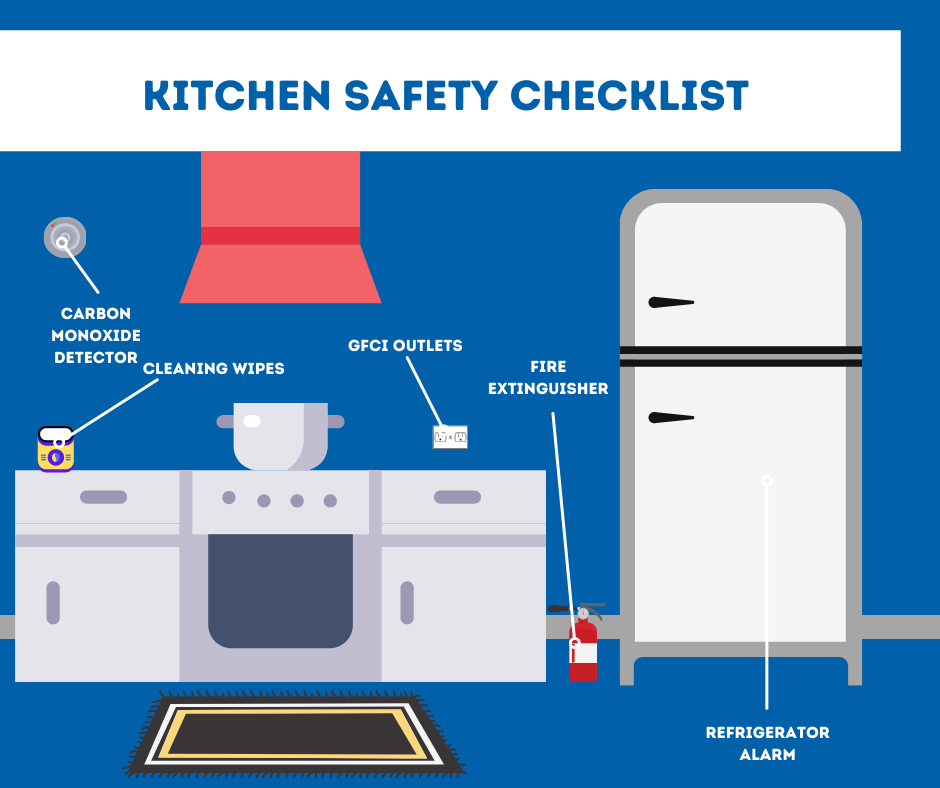
Kitchen Safety Checklist For Reno
The kitchen has plenty of items that should add comfort and safety to your house. Some of these items should be a snap to add and should be bought from the grocery store:
-
Fire Extinguisher: Fire can spring up from a neglected pot or a towel that’s too close to a burner. Always have a fire extinguisher in close reach for any stove or oven mishaps.
-
GFCI Box On Every Outlet: A circuit interrupter outlet should be used on outlets where there’s nearby water to lessen the chance of an electric shock. That means the plugs around your sink and kitchen counter. Since 1987, it’s been code to have one circuit interrupter outlet per dedicated circuit. But for simplicity’s sake, you’re going to want to have a single GFCI per outlet.
-
Monitored CO Detector: A carbon monoxide detector is handy in spaces that employ gas for the oven and range. If your gas lines malfunction, the CO detector will play a high-decibel sound and contact your monitoring agent.
-
Clorox Wipes Or Spray: The largest safety issue in the kitchen is the invisible bacteria and protein that comes with blood from meat and other foods. Always have antiviral wipes or an antibacterial spray to sanitize your area when cooking.
-
Refrigerator Alarm: The items in your fridge should remain at a chilly temperature to be healthy to use. If you leave the refrigerator door open too long, then an alarm beep will remind you to shut it securely. Some fridges come with a pre-installed alarm, some don’t, and you’ll have to pick up an external alarm from online.
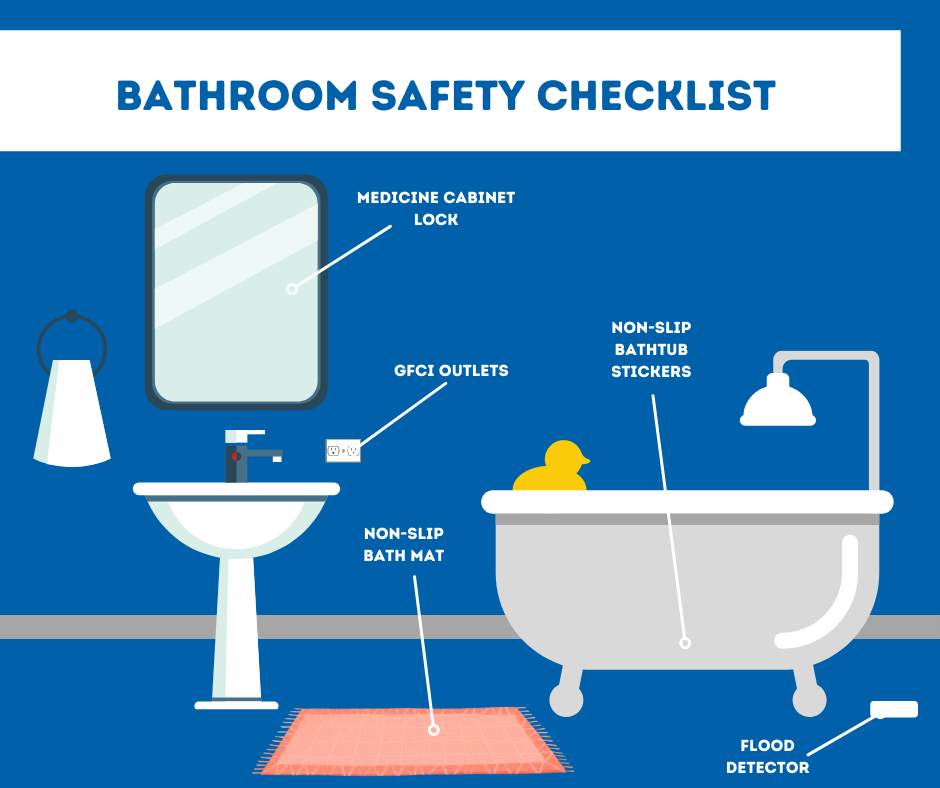
Bathroom Safety Checklist For Reno
Just because there’s not a lot of square footage in your bathroom doesn’t mean that there aren’t safety issues. From water problems to electric safety, here are a few safety ideas for your bathroom:
-
Flood Detectors: A leaking sink or shower can cause an expensive amount of water damage. Find out early about water problems with a flood detector before they generate hundreds of dollars in ruined floors, walls, and fixtures.
-
Textured Shower Mats: A slip in the bathroom can be devastating, causing bumps, gashed heads, or trips to the hospital. Make sure you avoid these hazards with a textured bathroom mat for while you towel off.
-
No-slip Bathtub Stickies: Another water hazard, a bathtub can be a slick area to move in. It’s a good idea that every has some textured stickers so your feet and toes have a bumpy patch to grip.
-
Medicine Door Lock: If you have young children or a family member with memory complications, you have to take additional attention regarding prescribed medicine. Hide away your prescriptions by getting a medicine cabinet with a child-proof lock.
-
GFCI Circuits: Just like the kitchen, you should also put in a safer circuit interrupter outlet on each bathroom circuit. This will cut the electricity if water splashes on them or there’s a sudden spike from an electric razor or hair dryer.
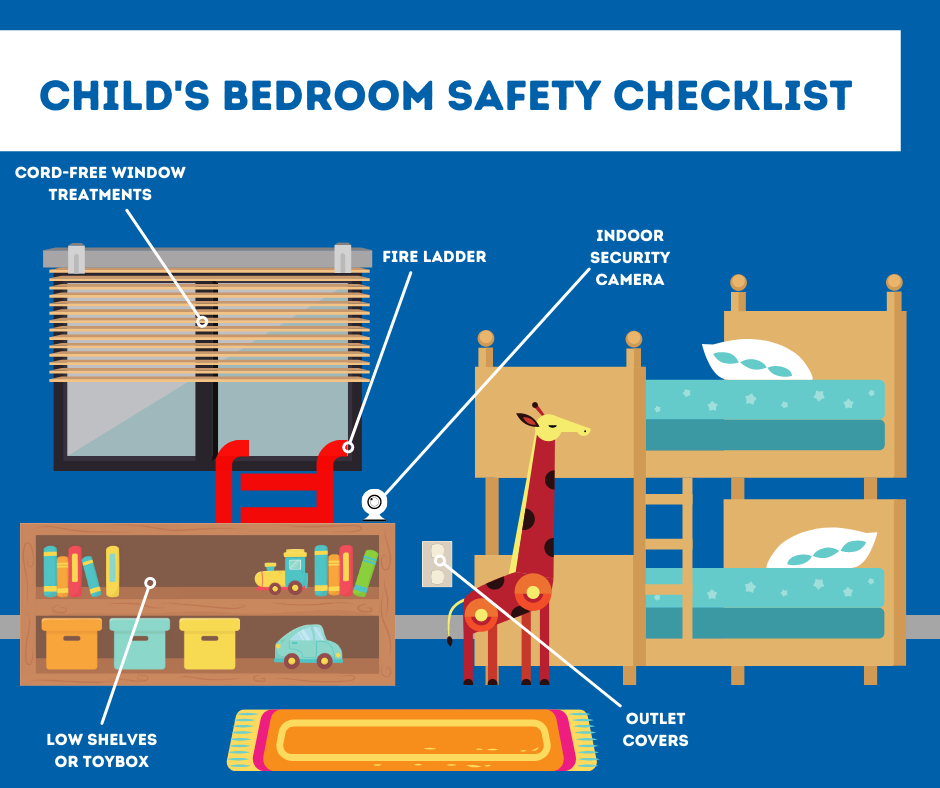
Child’s Bedroom Safety Checklist For Reno
A child’s bedroom should pair safety with manageability. If their window coverings or other items are safe but tricky to manage, then your child may perform risky methods -- like scale a bookshelf -- to touch them. Here are some easy, and safe, ideas:
-
No Cord Window Treatments: Safety professionals have long called window treatment cords an unsuspecting problem for children and animals. Install motorized treatments that your child can easily open and close with a remote control. Or better yet, connect your shades to your security system so they can raise automatically when the sun comes up, and lower at night for added darkness.
-
Indoor Security Camera: An indoor security camera perched on your child’s desk or dresser can double as an HD baby monitor that you can watch from a smartphone. And if they need something, they can use the 2-way talk feature on the camera.
-
Outlet Plug Covers: While every outlet should have outlet safety caps on them to protect your small children, this is doubly urgent in a child’s bedroom. It’s the one room in your house where your toddler will most likely play by themselves without consistent parental supervision.
-
Window Safety Ladder: If you use bedrooms on above the first story, then you will want to have a window fire ladder. These should help a young one get out of their room even if the hallway or downstairs are engulfed in smoke and fire. Remember to go over how to use them at least twice a year.
-
Toy Box Or Low Bookshelves: It’s interesting to think about a toy box as a safety component, but you’ll understand if you’ve ever walked on a building block in your stocking feet. A uncluttered floor let your child have a quick escape during a fire or break-in.
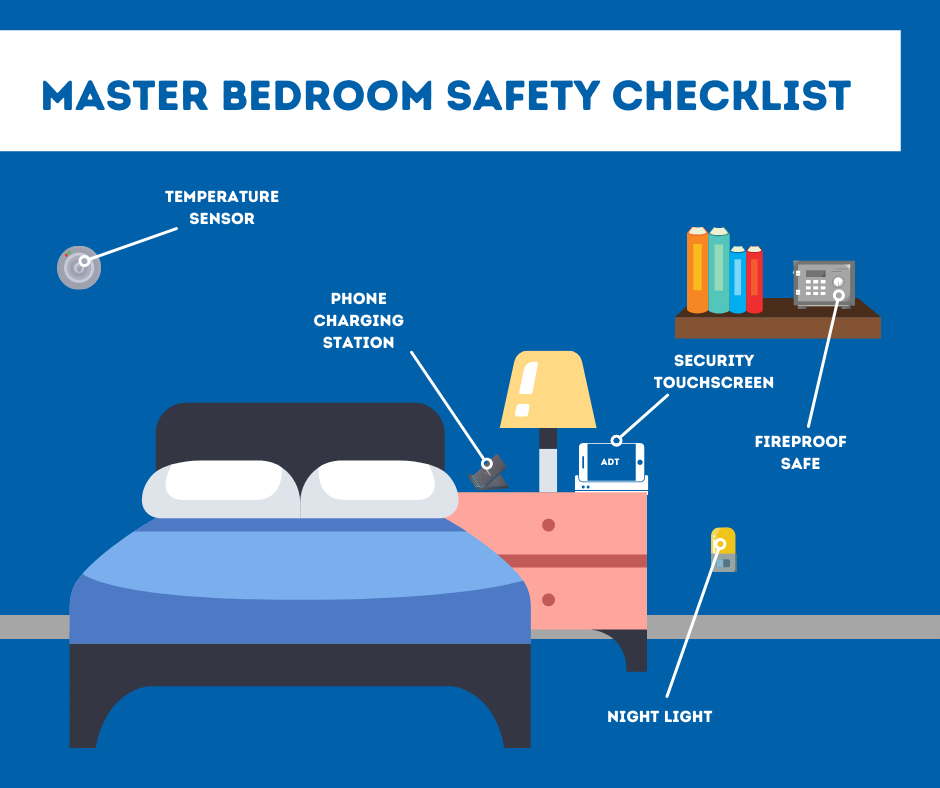
Main Bedroom Safety Checklist For Reno
The main bedroom should be an oasis, so let your safety components give you peace of mind when there's an emergency event. After all, being jerked awake by a wailing siren can be disorienting.
-
Smart Hub Touchscreen: Having a smart hub on your nightstand gives you a sense of what’s what that noise was without jumping out of bed. You could always turn on your ADT mobile app but, the touchscreen is often easier to control to use when you’re bleary-eyed and confused.
-
Phone Charging Station: We depend on our smartphones for so many things now alarm clocks, news readers, games, and --legend has it-- even phones. But, a dead device can cut us off from communications if there’s a problem. So, a charging station or cord is an important part of your nightstand.
-
Smart Lights Or Nightlights: A tiny light helps ground you when you’re jolted awake from a siren or other loud noises. If you won’t drift off to sleep with an outlet light, put in smart bulbs in your bedroom. Then you can have light simply with a push of a button or voice direction.
-
Fireproof Safe: Store your vital documents like insurance cards, passports, or banking information in a fireproof safe. Your lockbox can be a large one that sits out of the way or a slender handheld safe that you can grab when you leave during a fire or other emergency.
-
Heat Sensor: The drawback with most bedrooms is that they tend to be too stuffy or be frigid since they sit far from the thermostat. A temperature sensor will talk to your smart thermostat so you can have a nice, restful sleep at just the right temperature.
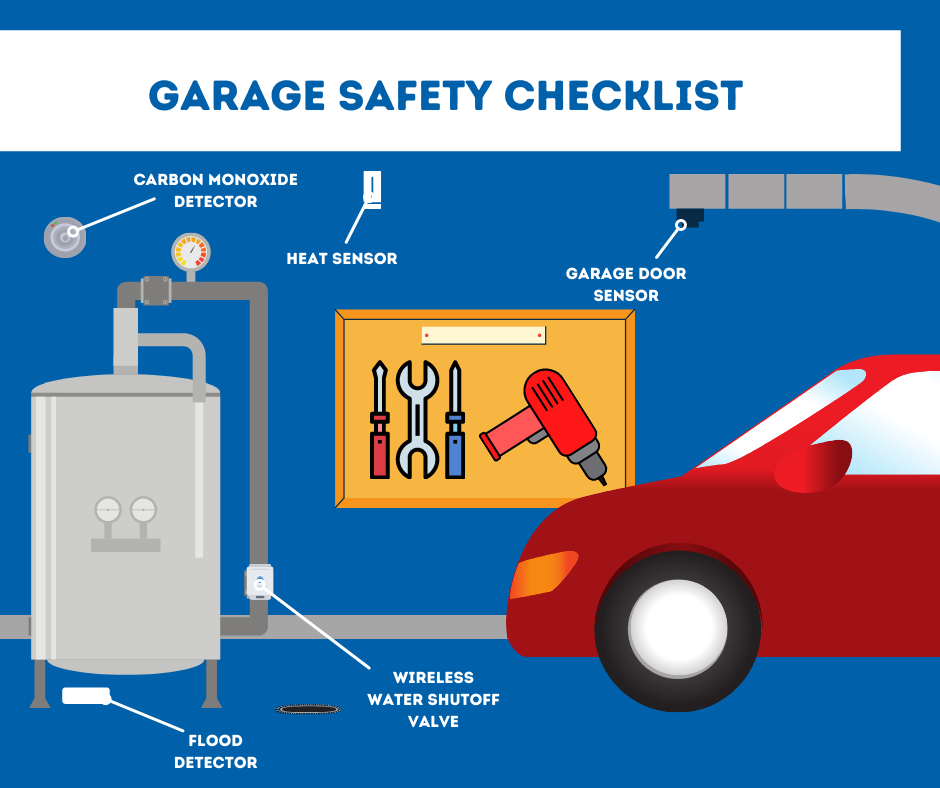
Basement/Garage Safety Checklist For Reno
Most safety needs in the basement or garage have to do with your pipes or heating system. Discovering problems early can stop bigger problems later on. So, as you look around your storage areas, pay attention to these critical items:
-
Water Detector Or Sump Pump Alarm: Installing a flood alarm in back of your water heater and sump pump drain can stop you from wading into a pond when you step into your garage or basement. The last you need is to waste the weekend getting rid of standing water and salvaging all those ruined boxes.
-
Carbon Monoxide Alarm: It’s nice to install a CO alarm in an area where a natural gas leak can happen. If you employ gas heating, try to put an alarm in the same room as your HVAC unit.
-
Remote Water Shutoff Valve: If your water alarm finds a plumbing leak or a burst pipe, then you will want to shut off the primary water line at once. With a WiFi shutoff valve, you can turn off your water flow from your phone. That’s nice when you’re visiting relatives and see a flood sensor alert on your smartphone.
-
Garage Door Sensor: Leaving the garage door up causes all types of problems. You can lose HVAC energy through that open door, and all sorts of animals or thieves can just walk in. A remote sensor will alert you to a neglected garage door and lets you lower it through the app.
-
Heat Sensor: A temperature sensor in your garage or basement is essential if you fret about frozen pipes. The temperature in these rooms can be drastically different than your main rooms of the home, so you will want to keep a closer eye on the temp through your mobile app.
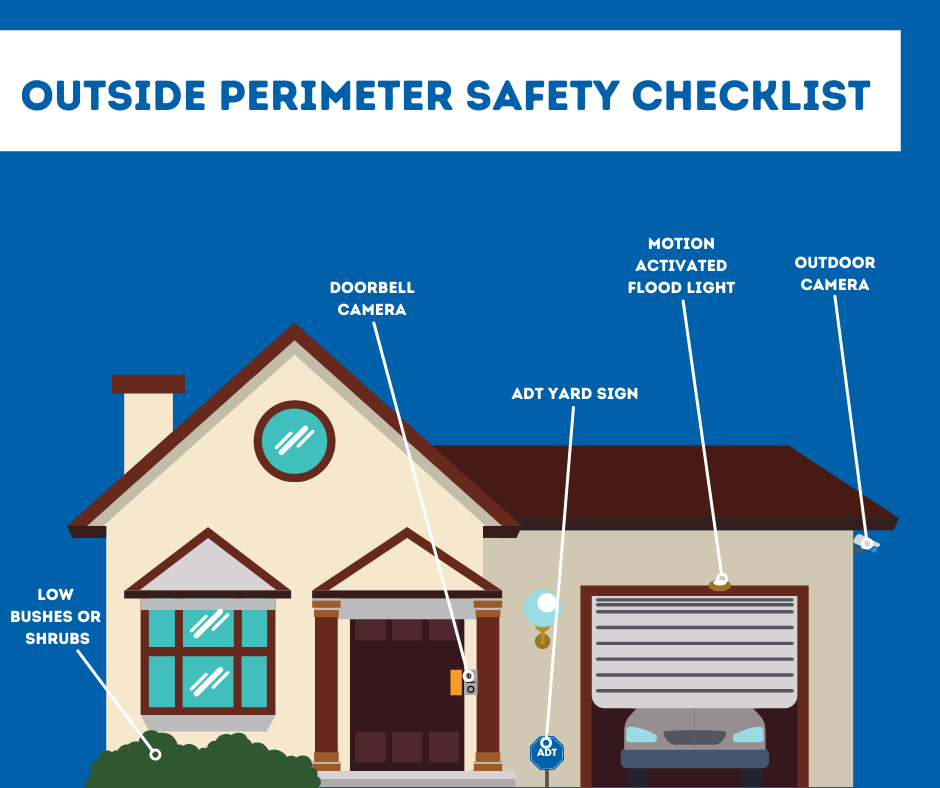
Outside Safety Checklist for Reno
Your yard, drive, and front porch are just as important to secure as the interior of your home. Use this checklist to defend your perimeter:
-
Doorbell Security Camera: See who’s arrived at the door before you open it and welcome guests. View packages and review video clips if they are stolen.
-
Outdoor Camera: You can place outdoor security cameras to guard against late night movement in your back yard. These security cameras are nice in areas where you might not have a window installed -- like around a cellar or by the garage.
-
Low Shrubs: High shrubs can create some serenity, but they also hinder your view of the outside. Don’t provide potential thieves an area to hide. Plus, tall bushes or trees around your structure can clog gutters and summon pests.
-
ADT Yard Signs: One of the biggest disincentives for a thief is alerting potential intruders that you own a monitored home security system. An ADT sign by the stoop and a window cling will alert ne'er-do-wells that they ought to keep walking to an less prepared target.
-
Motion Triggered Outside Lighting: Light is the greatest obstacle to those who sneak around in the dark. Motion-controlled lighting on your porch, garage, or deck can frighten possible intruders away. Flood lights also help you see the walk when you get to the house on those dark, winter nights.
Use Secure24 Alarm Systems To Help You Finish Your Home Safety Checklist for Reno
While Secure24 Alarm Systems can’t deliver non-security devices on your Reno home safety checklist, we can install a state-of-the-art security system. With alarms, security cameras, and home automation, we can personalize the perfect system for your home’s needs. Simply contact (775) 316-7001 for more information or fill out the form below. Or personalize your own solution with our Security System Designer.
